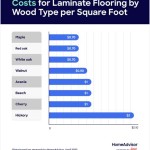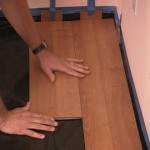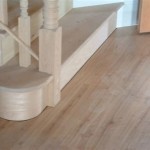Using Hardwood Flooring On Walls: A Comprehensive Guide
Hardwood flooring, traditionally associated with horizontal surfaces, is increasingly finding its way onto walls, transforming interior spaces with its warmth, texture, and aesthetic appeal. This trend, driven by a desire for unique design elements and a greater connection to natural materials, offers a compelling alternative to conventional wall coverings. This article will explore the benefits, considerations, installation techniques, and design possibilities associated with using hardwood flooring on walls.
Aesthetic and Practical Advantages
Employing hardwood flooring on walls presents numerous aesthetic and practical advantages. The inherent beauty of wood, with its varied grain patterns, colors, and textures, introduces a sense of natural elegance and sophistication to any room. Unlike paint or wallpaper, hardwood offers a three-dimensional quality, adding depth and visual interest to the wall surface. Different wood species, such as oak, maple, walnut, and cherry, provide a wide range of aesthetic options to complement diverse interior design styles, from rustic and traditional to modern and contemporary.
Beyond its aesthetic appeal, hardwood flooring on walls contributes to the acoustic properties of a space. The wood's natural density and cellular structure help absorb sound waves, reducing echo and reverberation. This characteristic makes it particularly beneficial in areas prone to noise, such as home theaters, offices, or living rooms. The degree of sound dampening will vary depending on the thickness and density of the wood used, as well as the presence of any insulation behind the wall.
Additionally, hardwood can offer a degree of insulation, helping to regulate temperature and reduce energy consumption. While the insulating properties of wood are not as significant as dedicated insulation materials, it provides a supplementary layer of thermal resistance, particularly in colder climates. This can contribute to a more comfortable and energy-efficient living environment.
Durability is another key advantage. Hardwood is highly resistant to scratches, dents, and other types of damage, making it a practical choice for high-traffic areas. Unlike paint or wallpaper, which can be easily scuffed or torn, hardwood surfaces can withstand the wear and tear of daily use, maintaining their appearance for years. Occasional cleaning with a damp cloth is typically all that is required to keep the wood looking its best.
Key Considerations Before Installation
Before embarking on a project involving hardwood flooring on walls, careful consideration must be given to several factors to ensure a successful and long-lasting installation. These factors include wall preparation, moisture control, weight considerations, and building codes.
Wall preparation is crucial. The wall surface must be clean, dry, and structurally sound. Any existing paint, wallpaper, or other wall coverings should be removed. The wall should be as level and even as possible to ensure that the hardwood planks are installed flush and without gaps. If the wall is uneven, it may be necessary to apply a leveling compound or furring strips to create a smooth, consistent surface.
Moisture control is of paramount importance. Wood is a hygroscopic material, meaning it absorbs and releases moisture based on the surrounding environment. Excessive moisture can cause wood to swell, warp, or even rot. Therefore, it is essential to ensure that the wall is properly insulated and protected from moisture penetration. A vapor barrier may be necessary to prevent moisture from migrating from the wall cavity into the wood. Acclimation of the hardwood flooring to the room's humidity levels before installation is also critical. The planks should be stored in the room for several days to allow them to adjust to the ambient temperature and humidity, minimizing the risk of expansion or contraction after installation.
Weight is another significant consideration. Hardwood flooring is relatively heavy, and the wall structure must be capable of supporting the added weight. It is important to consult with a structural engineer or experienced contractor to assess the load-bearing capacity of the wall and determine whether any reinforcement is required. In some cases, it may be necessary to add extra studs or bracing to the wall to ensure that it can safely support the weight of the hardwood. This is especially critical for walls that are not load-bearing.
Finally, it is essential to comply with all applicable building codes and regulations. Local building codes may specify requirements for fire resistance, ventilation, and other safety aspects. It is advisable to consult with the local building department to ensure that the installation meets all applicable codes. This may involve using fire-retardant coatings or other measures to enhance the safety of the installation.
Installation Techniques and Best Practices
Several installation techniques can be employed to attach hardwood flooring to walls, each with its own advantages and disadvantages. The choice of technique will depend on factors such as the type of flooring used, the condition of the wall, and the desired aesthetic. Common methods include direct glue application, nail gun attachment, and clip or track systems.
Direct glue application involves applying adhesive directly to the back of the hardwood planks and then pressing them firmly against the wall. This method is relatively simple and straightforward, but it requires a smooth, even wall surface. It is also important to use a high-quality adhesive that is specifically designed for bonding wood to drywall or other wall surfaces. The adhesive should be applied evenly to the entire back of the plank to ensure a strong and secure bond. This method is typically best suited for smaller installations or when using engineered hardwood flooring, which is lighter than solid hardwood.
Nail gun attachment involves using a nail gun to fasten the hardwood planks to furring strips or directly to the wall studs. This method provides a stronger and more secure attachment than direct glue application. Furring strips are typically attached to the wall first, providing a nailing surface for the hardwood planks. The planks are then nailed to the furring strips using a finish nailer. This method is suitable for both solid and engineered hardwood flooring and is often preferred for larger installations. It is important to use nails that are long enough to penetrate the furring strips or wall studs sufficiently to provide adequate holding power.
Clip or track systems offer a more sophisticated and often more expensive method of installation. These systems typically involve attaching metal clips or tracks to the wall and then snapping or sliding the hardwood planks into place. This method allows for easy installation and removal of the planks, making it ideal for creating removable or interchangeable wall panels. Clip or track systems are often used in commercial settings or when a more refined and professional look is desired. They also allow for expansion and contraction of the wood, reducing the risk of warping or cracking.
Regardless of the installation technique chosen, it is important to use proper safety precautions. Safety glasses, gloves, and a dust mask should be worn to protect against flying debris, splinters, and dust. Power tools should be used with caution and according to the manufacturer's instructions. Proper ventilation should be provided to minimize exposure to fumes from adhesives or finishes. A level, measuring tape, and saw are essential tools for ensuring accurate and precise cuts and placements.

How To Install Wood Flooring On The Wall Esb

Installing Wood Flooring On Walls Newlywoodwards

Going Up The Wall Installing Flooring Vertically Floor Trends Installation

How To Use Wooden Flooring As A Stunning Feature Wall Discount Depot Blog

Wood Flooring Feature Walls Direct

Engineered Wood Flooring As An Accent Wall Builddirect Blog

Engineered Wood Flooring As An Accent Wall Builddirect Blog

Accent Wall Made From Engineered Hardwood Flooring Air Nailed To The Used Three Colors Pattern On Walls Reclaimed Wood

Interested In A Wood Accent Wall

Wood Flooring On Accent Walls Carlisle Wide Plank Floors
Related Posts








